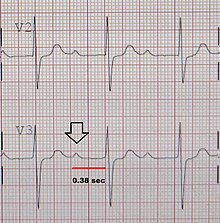User:Mr. Ibrahem/First-degree atrioventricular block
| First-degree AV block | |
|---|---|
| Other names | First degree heart block, PR prolongation |
 | |
| An ECG showing a first degree AV block of greater than 300 ms | |
| Specialty | Cardiology |
| Symptoms | None[1] |
| Complications | Progression to second or third degree AV block[2] |
| Causes | Normal, heart attack, myocarditis, high blood potassium, certain medications[3] |
| Diagnostic method | Electrocardiogram (ECG)[3] |
| Differential diagnosis | Second-degree AV block, third-degree AV block[2] |
| Treatment | Routine follow-up, avoidance of certain medication[2] |
| Prognosis | Good[3] |
| Frequency | 5% of people over 50 years[4] |
First-degree atrioventricular block (first degree AV block) is were the electrical signal from the upper to lower chambers of the heart is delayed but not interrupted.[3] It generally results in no symptoms.[1] Rarely there may be shortness of breath, tiredness, and lightheadedness.[2] Complications may include atrial fibrillation or progress to second- or third-degree AV block.[2]
It occur occur normally in younger people and athletes.[1] Other causes include a heart attack, myocarditis, high blood potassium, and certain medications such as beta blockers, calcium channel blockers, and digoxin.[3] Diagnosis is by an electrocardiogram (ECG) showing a PR interval of greater than 200 milliseconds without any dropped beats.[3] The condition is considered "marked" is greater than 300 milliseconds.[3] It is a type of atrioventricular block.[3]
No specific treatment is generally required.[1] Medications that can worsen the condition may be stopped.[3] Rarely in those with marked disease and symptoms a pacemaker may be placed.[2] In young people brief episodes of first degree AV block and common though ongoing issues affects less than 1%.[4] In becomes more common with age affecting about 5% of people over the age of 50.[4] Males are more commonly affected than females.[2]
References[edit]
- ^ a b c d "Atrioventricular Block - Cardiovascular Disorders". Merck Manuals Professional Edition. Archived from the original on 6 April 2010. Retrieved 29 December 2020.
- ^ a b c d e f g Oldroyd, SH; Quintanilla Rodriguez, BS; Makaryus, AN (January 2020). "First Degree Heart Block". PMID 28846254.
{{cite journal}}: Cite journal requires|journal=(help) - ^ a b c d e f g h i Kashou, AH; Goyal, A; Nguyen, T; Chhabra, L (January 2020). "Atrioventricular Block". PMID 29083636.
{{cite journal}}: Cite journal requires|journal=(help) - ^ a b c Saksena, Sanjeev; Camm, A. John (2011). Electrophysiological Disorders of the Heart E-Book: Expert Consult. Elsevier Health Sciences. p. 521. ISBN 978-1-4377-0971-1. Archived from the original on 2021-08-28. Retrieved 2020-12-29.
